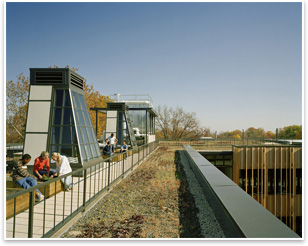
|
U.S. Mayors Champion the Greening of America’s Schools
Citing the urgent need for healthier and more productive places of learning, the mayors issued the resolution on behalf of the 55 million students and 5 million faculty and staff who spend their days in school buildings. “Studies show that children in green schools are healthier and more productive because of improved indoor air quality, lower levels of chemical emissions, and a generous provision of natural day lighting,” said Mayor Cownie. “The benefit of cleaner indoor air quality—a key emphasis of green schools—have been linked to lower asthma rates, fewer allergies, reduced absenteeism, and increased teacher retention rates.”
To date, more than 30 schools have received LEED certification, and nearly 300 more are on a waiting list for certification from the USGBC. A recent study by Capital E, a national clean energy technology and green building consulting firm, indicates that a typical green school involves a 2 percent increase in cost, but would save $100,000 per year in energy costs alone—enough to hire two new teachers, buy 500 new computers, or purchase 5,000 new textbooks.
|
||
Copyright 2007 The American Institute of Architects. All rights reserved. Home Page |
||
news headlines
practice
business
design
Recent related
› New Report Shows Green Schools Save Money, Energy; Promote Good Health
CAE Fall Conference: Redefining Sustainability: New Directions for Designing Our Future
Join the Committee on Architecture for Education for their fall meeting September 16—18, in Seattle, as the group explores modernization of schools built in the ’50s and ’60s as well as new school construction—all in the light of sustainable design. Visit the CAE Web site for more information or to sign up.
Photos:
Pictured, bottom, is Seattle’s Benjamin Franklin Elementary School by Mahlum Associates, a 2006 COTE Top Ten Green Projects recipient and one of the conference’s tour sites.
Photo, top, Sidwell Friends Middle School, Washington, D.C., by KieranTImberLake Associates, is a 2007 COTE TOP Ten Green Buildings Award recipient and a LEED® Platinum candidate.


